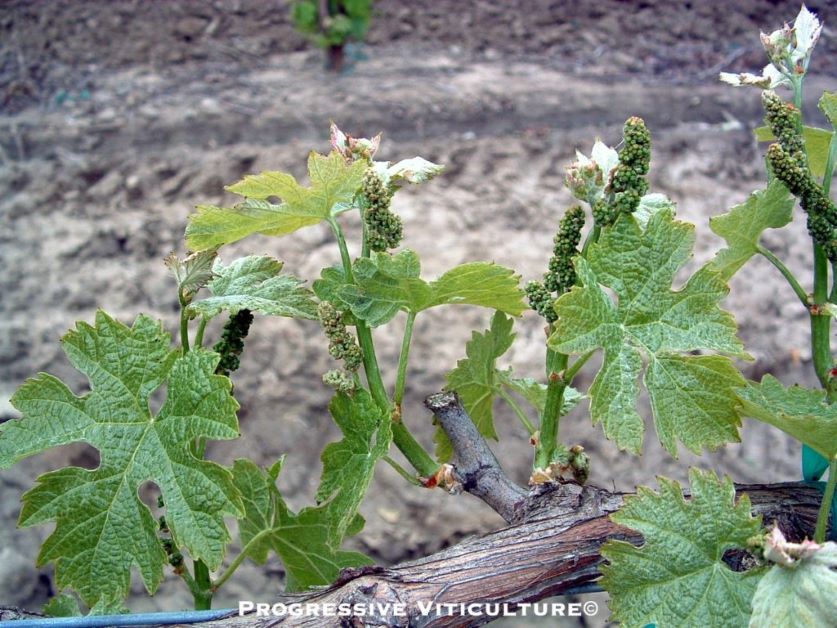MARCH 2, 2020. BY STAN GRANT, VITICULTURIST.
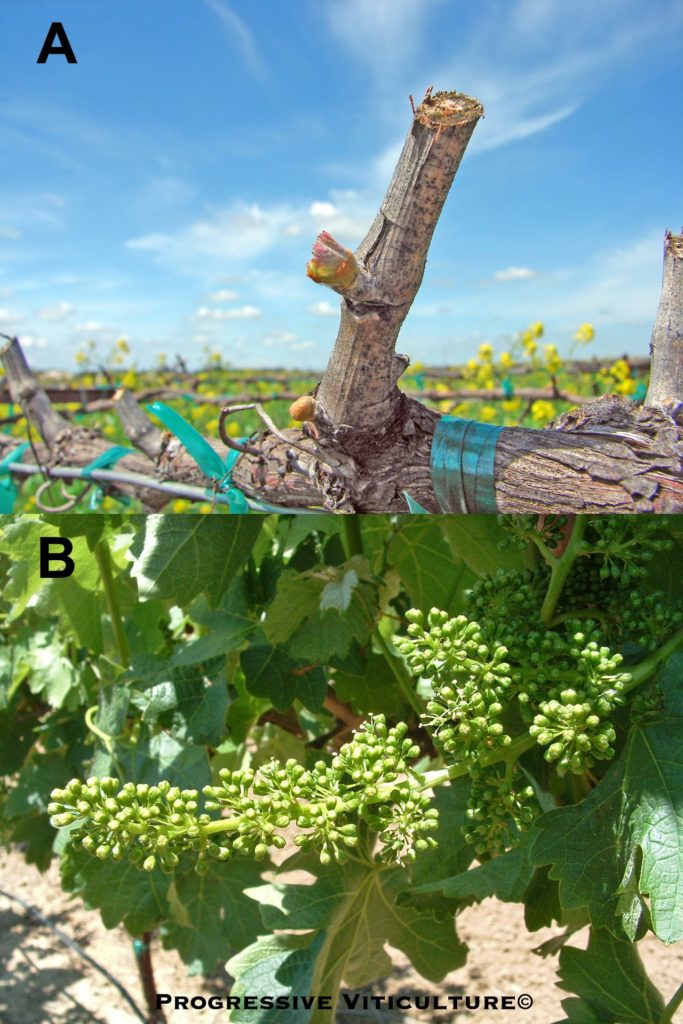
Figure 1. The prebloom period begins with budbreak (A) and ends with the onset of bloom (B). (Progressive Viticulture©)
Prebloom is one of the busiest times in the vineyard and for good reason. Shoot and roots are rapidly growing to build the foundation for fruit production. During the same time, unfavorable weather and excessively wet, cool soils can challenge their development. In addition, vineyard pests and diseases are lurking, waiting for their opportunity to proliferate and harm them. These are demanding circumstances for vineyard managers.
Prebloom begins as shoots emerge from buds on spurs and canes, and it ends when flowers begin to bloom (Figure 1). At the outset, shoot emergence is partially a function of management activities during the previous growing season and during dormancy. In fact, a high degree of uniformity in shoot emergence and growth is an indicator of diligent past vineyard management.
Early Season Root Activities and Root Zones
Shoot emergence and initial growth depends on nutrients remobilized from stored reserves, including carbohydrates, in woody vine tissues and growth stimulating hormones received from the roots. Therefore, an optimized root environment, especially with regard to moisture, aeration, and temperature, is critical. Bleeding pruning cuts indicate adequate soil moisture, but regardless, directly assessing soil water status near budbreak is always prudent.
Root zone management for maximum soil permeability and warming is an on-going, long-term endeavor and in any given year, prebloom management options are somewhat limited. Foremost among those available are tillage alternatives. Tilling cover crop residues conserves root zone moisture and accelerates soil warming. This is a good option for drought years and dry farmed vineyards, and for vineyards on clayey soils high in organic matter that are slow to warm. Non-tillage, on the other hand, typically favors soil aeration and drying, which may be desirable during wet springs and for poorly drained soils. If electing to till, take care to do so while soils are not wet to avoid compaction (Figure 2).
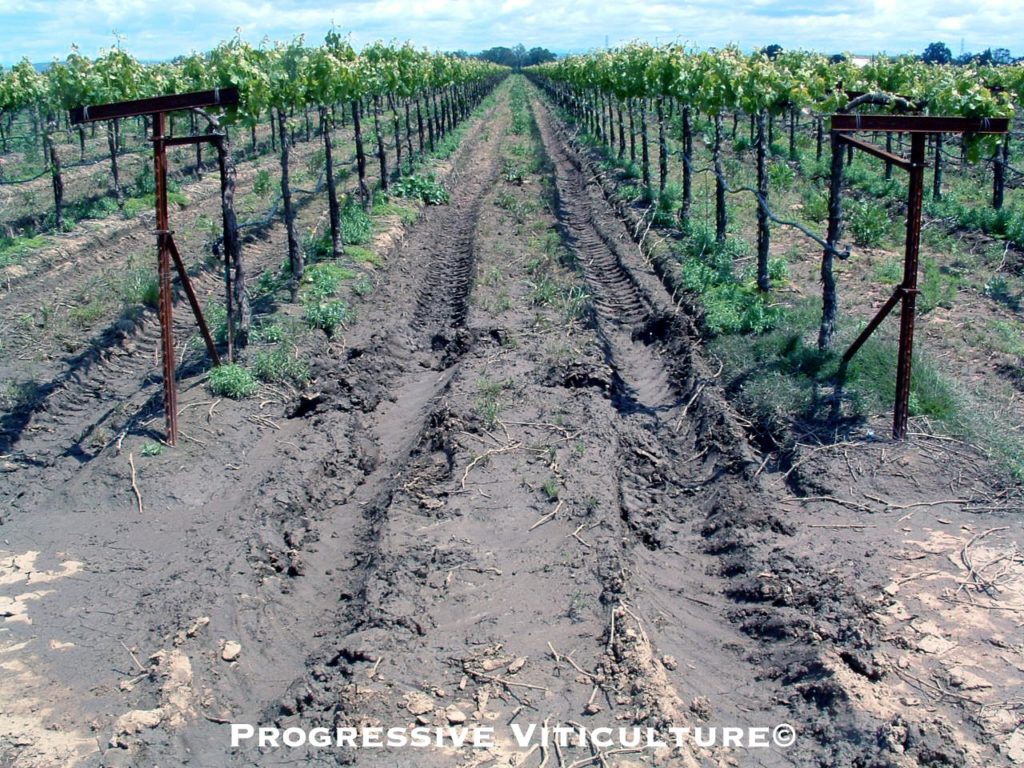
Figure 2. Mechanized vineyard operations compact wet soil. (Progressive Viticulture©)
A balanced supply of mineral nutrients in the root zone soil, especially with regard to the nitrogen, phosphorus, calcium, copper, and boron, supports optimum early season root activity. Several fertilizers have been developed to enhance root activities, including Redox Rootex and Mar Vista Foundation MVR. Such fertilizers contain organic acids and other stimulatory components.
Early Season Shoot Growth and Foliar Applied Materials
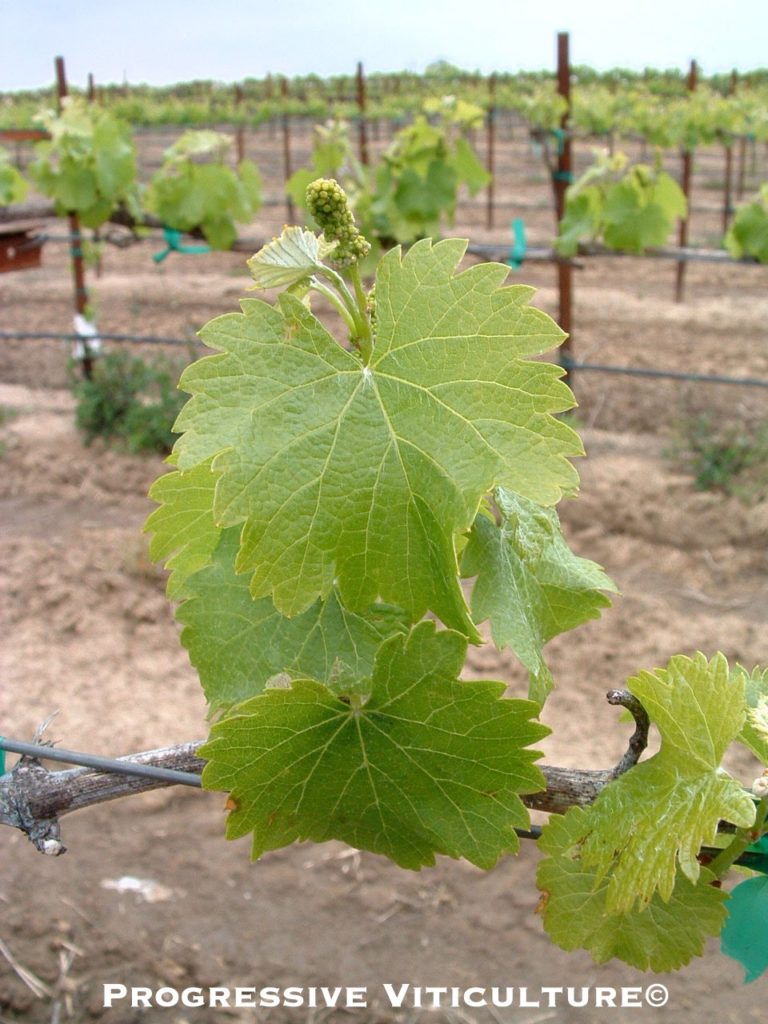
Figure 3. Pale early season grapevine foliage. (Progressive Viticulture©)
After shoots have 5 or 6 unfolded leaves, they can synthesize sufficient carbohydrates to meet their needs and are no longer solely dependent on remobilized reserves from woody tissues. At this time, the rates of shoot and canopy growth become important vineyard management concerns because the photosynthetic machinery for ripening depends upon them. Of course, protecting the foliage from damaging pests and diseases is also important.
Fertilizers applied directly to the vine foliage are beneficial during this time, particularly where root activity is limited, shoot growth is restricted, or foliage is pale (Figure 3). Normally, the greatest early prebloom benefits come from foliar applied nitrogen, phosphorus, calcium, and micronutrients. Low biuret urea is an efficacious and cost of effective foliar nitrogen fertilizer. For other mineral nutrients, fertilizers designed specifically for foliar application are usually most effective, including formulations involving organic acid complexes, carbohydrate complexes, and amino acid chelates.
Foliar applied phosphite fertilizers carry mineral nutrients to the roots, thereby enhancing root activities. When the supply of hormones from the roots is inhibited, foliar applications of hormone containing kelp and seaweed based materials may enhance shoot growth. Foliar fertilization is again important late in the prebloom period when there is a spike in nutrient demand for fruit set. At this time, phosphorus, zinc, boron, and molybdenum are mineral nutrients of concern.
Early Season Canopy Monitoring and Resourcing
An important early season canopy development goal is 10 to 12 nodes and leaves per shoot at the onset of bloom. On the way towards achieving this goal, the rate of shoot growth ought to be moderate and steady, with internodes 3 to 4 inches in length and leaves of normal size for the variety. Under some circumstances, soil moisture stored from winter rains and mineral nutrients stored in the vine and available in the soil are sufficient to achieve these shoot growth goals.
In other situations, growth vigor is too low and supplemental water and nutrients are required (Figure 4). Water stress before, during, and immediately after bloom is a particular concern because it can reduce fruit set. Use soil moisture measurements, leaf water potential, and the appearance of the foliage as guides for scheduling irrigations. Tissue analysis results can indicate mineral nutrient shortages, but the laboratory processing time is usually too long to be useful for managing rapidly changing vine development early in the growing season. Ordinarily, we have to discern the need for fertilizer nutrients from shoot growth characteristics and color.
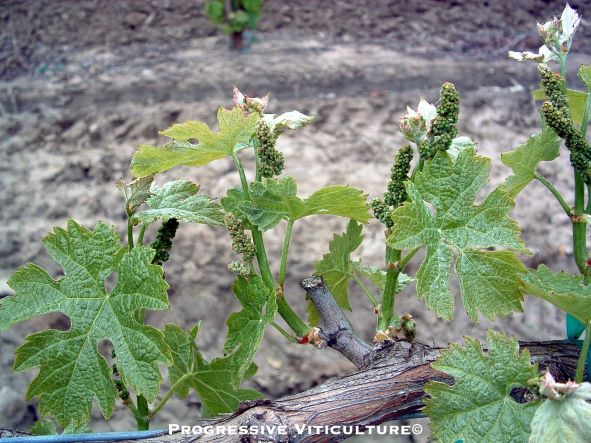
Figure 4. Early season restricted shoot growth, with cluster development advanced ahead of shoot elongation. (Progressive Viticulture©)
The opposite state of affairs also happens, with shoot growth vigor in excess. Long, wide, and flat internodes and large, dark leaves are among the symptoms of an overabundance of water and nutrients, especially nitrogen, in the vineyard soil. Reducing growth vigor requires measures, such as competitive cover crops and altered vineyard designs, which are beyond the scope of prebloom management activities and this article.
Early Season Canopy Management Practices
During prebloom, it is not enough to simply grow shoots. For most trellis-training-pruning systems, they must also be spaced and positioned to promote leaf exposure to direct sunlight and internal fruit zone exposure to air movement and dappled sunlight. To achieve this, thin shoots to 5 to 6 per foot of cordon (https://www.lodigrowers.com/shoot-thinning/).
Thinning while shoots are 6 to 12 inches long is most effective for conserving vineyard resources and containing labor costs. In windy areas where shoot breakage is common, delay thinning until shoots are longer and firmly attached to the vine. For those trellises with movable foliage wires, move them into position after the shoots are a few inches longer than necessary for capturing and confining them.
Early Season Foliage Protection
Young shoot tissues are tender and susceptible to damage. For this reason, prebloom foliage protection is necessary to preserve leaf function and cluster viability.
Given the extensive damage possible over a very short period time, frost protection is foremost among prebloom protection concerns. Measures to avoid or minimize frost damage include the indirect or passive, such as copper sprays and cover crop mowing or disking, as well as the active, such as irrigations or wind machine operation during periods of cold temperatures (https://www.lodigrower s.com/frost-management-strategies-for-vineyards/).
Diseases are also an important prebloom foliage damage concern. Powdery mildew is an ever present threat to juvenile foliar tissues and when conditions are favorable, they must have fungicide protection in place to prevent infection. For larger vineyard operations and highly susceptible varieties, regular prophylactic treatments are appropriate, while for smaller operations and less susceptible varieties, scheduling fungicide applications with the Gubler-Thomas powdery mildew disease model is a method that contains operating costs.
Rainy weather diseases sometimes develop prior to bloom, including Botrytis shoot blight, Phomopsis cane and leaf spot, and under rare circumstances, downy mildew. There are efficacious fungicides for all of these diseases that can protect susceptible varieties under wet conditions.
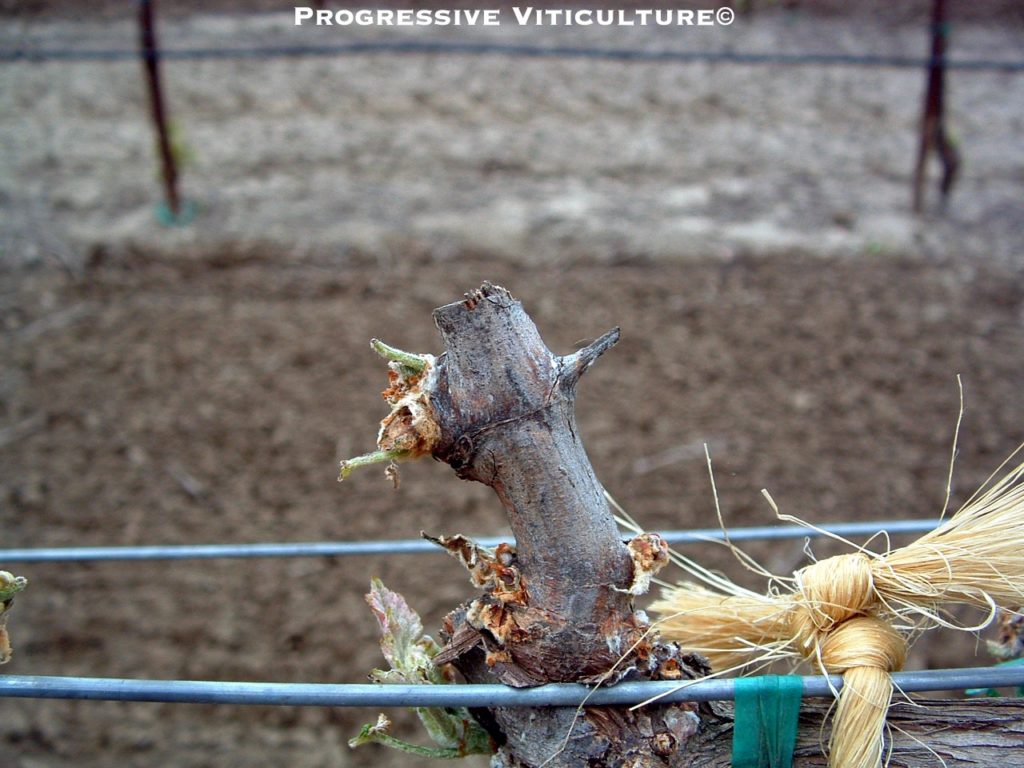
Figure 5. An absence of leaves after being consumed by cutworms. (Progressive Viticulture©)
Rodent pests, including gophers and voles, are active in the spring. Also, certain insect pests, such as worms, thrips, mealybugs, and leafhoppers, may require control prior to bloom (Figure 5). Commonly, these pests cause significant damage in only small sections of vineyards and as a result, require localized treatment.
In Summary
The prebloom period is one of the busiest in our vineyards. Our early season management activities are vital to sustained vineyard profitability, affecting fruit production this year and carrying over into the next. Accordingly, prebloom is the time to help vines build the foundation for production and protect it.
This a modified version of an article published in the Mid Valley Agricultural Services March, 2012 newsletter. Article was updated for this blog post on 3.2.2020.
Further Reading
Anonymous. Frost damage a hot topic in New Zealand. Aust. Vitic. p. 43-45. May-Jun 2003.
Anonymous. Canopy management assists frost response. Aust. Vitic. p. 81. Jul-Aug 2003.
Bettiga, LJ (Ed.). Grape pest management. 3rd Ed. University of California Agricultural and Natural Resources, Oakland, CA. Publication 3343. Pp. 120-125. 2013.
Donaldson, DR; Snyder, RL; Elmore, C; Gallagher, S. Weed control influences vineyard minimum temperatures. Am. J. Enol. Vitic. 44, 431-434.
Galet, P. General Viticulture. Oenoplurimedia, Chateau de Chaintre, France. 2000.
Grant, S. Balanced soil fertility management in wine grape vineyards. Practical Winery and Vineyard. 24 (1): 7-24. May/June 2002.
Grant, S. Frost management strategies for vineyards. Lodi Winegrape Commission Coffee Shop. (www.lodigrowers.com). April 03, 2017.
Grant, S. Shoot thinning. Lodi Winegrape Commission Coffee Shop. (www.lodigrowers.com). May 02, 2017.
Hillel, D. Introduction to soil physics. Academic Press, New York. 1982
Kasimatis, AN; Bearden, BE; Sisson, RL; Parsons, RA; Reed, AD; Bowers, K. Frost protection for North Coast vineyards. Univ. Calif. Div. Agric. Nat. Res. Leaflet 2743. 1979.
Keller, M. The science of grapevines. Academic Press, Burlington, MA. 2010
Lindow, SE; Connell, JH. Reduction of frost injury to almond by control of ice nucleation active bacteria. J. Am. Soc. Hort. Sci. 109, 48-53. 1984.
Mullins, MG; Bouquet, A; Williams, LE. Biology of the grapevine. Cambridge University Press. 1992.
Ohmart, CP, Storm, CP, Matthiasson, SK (Eds.). Lodi Winegrower’s Workbook, 2nd Ed. Lodi Winegrape Commission. pp. 187-267. 2008.
Richards, D. The grape root system. In Janick, J (Ed.). Hort. Rev., Vol. 5. John Wiley and Sons, Hoboken, NJ. 1983.
Smart, R: Robinson, M. Sunlight into wine: A Handbook for Winegrape Canopy Management. Winetitles, Adelaide. 1991.
Snyder, RL; Tau Paw U, K; Thompson, JF. Passive frost protection of trees and vines. Univ. Calif. Div. Agric. Nat. Res. Leaflet 21429. Undated.
Snyder, RL; Connell, JH. Ground cover height affects pre-dawn orchard floor temperature. Calif. Agric. 47, 9-12. Jan-Feb 1993.
Striegler, RK. Spring frost protection in vineyards. Am. Vineyard. p. 4-5, 24-26. Mar 1995.
Striegler, RK; Jorgensen, G; Escalera, B; Berg, GT. Microsprinkler frost protection proves reliable. p. 8, 26-27. Am. Vineyard. Mar 1996.
Wilcox, WF; Gubler, WD; Uyemoto, JK (ed.). Compendium of Grape Diseases. 2nd ed. APS Press, St. Paul, MN. pp. 33-39. 2015.
Winkler, AJ; Cook, JA; Kliewer, MK; Lider, LA. General Viticulture. Univ. Calif. Press, Berkeley, 1974.
Have something interesting to say? Consider writing a guest blog article!
To subscribe to the Coffee Shop Blog, send an email to stephanie@lodiwine.com with the subject “blog subscribe.”
To join the Lodi Growers email list, send an email to stephanie@lodiwine.com with the subject “grower email subscribe.”
To receive Lodi Grower news and event promotions by mail, send your contact information to stephanie@lodiwine.com or call 209.367.4727.
For more information on the wines of Lodi, visit the Lodi Winegrape Commission’s consumer website, lodiwine.com.

